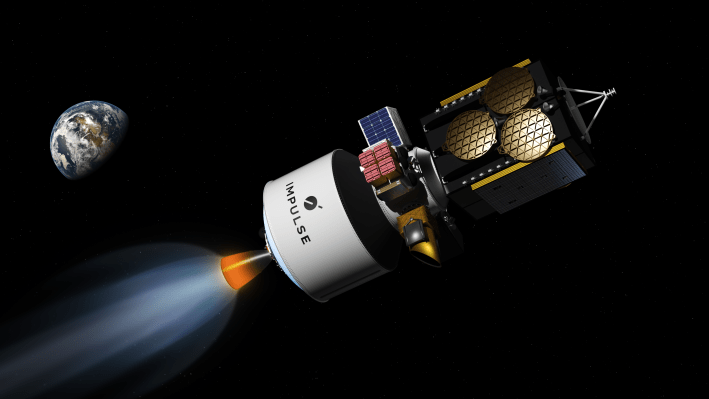Impulse Space revealed more details today about its next product, a high-energy kick stage called Helios, that could make getting to geosynchronous orbit cheaper than ever before.
The vast majority of spacecraft are launched to low Earth orbit, or LEO, which is at an altitude of 1,200 miles or less from Earth. But when firms want to send a satellite to geosynchronous orbit (GEO), which is around 22,000 miles away, they have two main options. They can book a ride on the very few rockets that can take the payload directly to GEO, like SpaceX’s Falcon Heavy or United Launch Alliance’s Atlas V; or companies can book a Falcon 9 and go to an intermediate orbit called geostationary transfer orbit (GTO) and use onboard propulsion to get the spacecraft the rest of the way.
The former option is expensive; the latter is time-consuming, with trips from GTO to GEO taking up to 6-8 months. Impulse Space is offering a third way: an expendable Helios kick stage that’s compatible with existing medium-lift launch vehicles. Instead of taking 6-8 months to go from GTO to GEO, Helios will be able to take payloads of up to five tons from the lower LEO directly to GEO in less than 24 hours.
“I always wanted to do a high-energy stage, so it’s been in my mind for a long time,” Impulse CEO Tom Mueller said. “We talked about doing this type of thing at SpaceX, so it’s not exactly new. It’s just a different way to implement it with cryogenic propellants.”
Mueller is well-known in the space propulsion world: he worked as CTO of Propulsion at SpaceX and led development of the Merlin rocket engine, which still powers the Falcon 9 workhorse rocket, and the Draco engines on the Dragon spacecraft.
Impulse, which he founded in September 2021, has already developed and launched its first product, a spacecraft for last-mile deliveries called Mira. As one would expect, the thrusters on both Mira and Helios (called Saiph and Deneb, respectively) were designed in-house. But as already mentioned, Helios must pack considerably more punch: It takes over 4,000 meters per second to get from LEO directly to GEO, so the kick stage will burn up to 14,000 kilograms of propellant across each mission.
Helios will use cryogenic propellants, like liquid oxygen and liquid methane, the same fuels that power next-gen rocket engines like SpaceX’s Raptor and Relativity Space’s Aeon R. The big challenge of using cryogenic propellants actually comes before launch: They need to be stored in the fairing prior to launch, but in such a way that they don’t simply boil off. The challenges are not insurmountable — in fact, Intuitive Machines’ Nova-C lunar lander, which is poised to go to the moon in February, is using cryogens — but it does add more engineering challenges.
But the challenges are worth it, according to Mueller. Cryogens are cheap, non-toxic and not particularly rare — though very high-performance — which will help drive the cost of Helios down even more.
In many ways, Helios is a bet on where the industry is heading: If the cost of getting to GEO goes down, demand for GEO transportation services will go up. But even if this isn’t the case, Mueller said there’s already a good market in the approximately 15-20 launches that go to GEO each year.
“If we can capture some fraction of those, that’s a great market for us,” he said. “I think that as Starlink and Kuiper and all the other LEO constellations reach their peak and max out LEO, the next move to move data will be back to GEO.”
Plus, because the stage is designed to be so high-energy, Helios would also be able to serve missions going to lunar or solar orbits, and the Lagrange points. Impulse is aiming to conduct the first test fire of Deneb this year, at the company’s testing facilities at California’s Mojave Air and Space Port, followed by a first demo launch in 2026.
“What SpaceX and other launch vehicles have done to reduce the cost of access to LEO, we want to do to greatly reduce the cost of access to all other higher-energy orbits within and above LEO,” Mueller said.
“This is just a solution that rounds off all the corners and gets down to what’s the lowest cost kilograms to GEO that can be achieved with current technology. This is zeroed in on it.”
